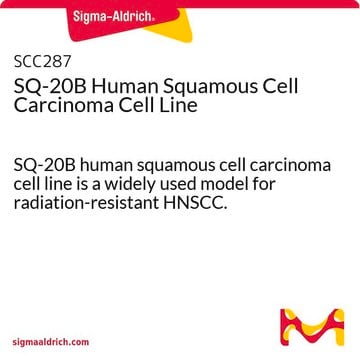SCC280
SCC-61 Human Squamous Cell Carcinoma Cell Line
SCC-61 human squamous cell carcinoma cell line is a good model for studying radiation resistance in SCC cancer cells.
Sign Into View Organizational & Contract Pricing
All Photos(1)
About This Item
UNSPSC Code:
41106514
NACRES:
NA.81
Recommended Products
application(s)
cell analysis
General description
Squamous cell carcinoma of the head and neck (HNSCC) is the 9th-most common cancer worldwide and is characterized by a high rate of recurrence after therapy, with a median 5-year survival range of 40-50% (1). HNSCC tumors show a wide range of heterogeneity in response to radiation therapy. Cellular HNSCC models that demonstrate a range of radiation sensitivity are thus invaluable for elucidating the factors underlying radiation responses of cancer cells.
The SCC-61 HNSCC cell line, derived from an aggressive tongue squamous cell carcinoma (2), is an established model for HNSCC. SCC-61 cells are relatively sensitive to radiation compared to other HNSCC cell lines as well as a relatively stable genome (3). SCC-61 cells grow robustly and are strongly adherent in culture. SCC-61 cells have been characterized by positive expression of the SCC marker p63 (p40) (4). SCC-61 cells have demonstrated utility in studies parsing mechanisms of radio-resistance in SCC tumor cells, as demonstrated by transformation of this cell line with factors conferring radio-resistance (5).
<bold>Source:</bold>
SCC-61 cell line was derived from a tongue squamous cell carcinoma of a male patient (2).
Research Category:
Cancer
The SCC-61 HNSCC cell line, derived from an aggressive tongue squamous cell carcinoma (2), is an established model for HNSCC. SCC-61 cells are relatively sensitive to radiation compared to other HNSCC cell lines as well as a relatively stable genome (3). SCC-61 cells grow robustly and are strongly adherent in culture. SCC-61 cells have been characterized by positive expression of the SCC marker p63 (p40) (4). SCC-61 cells have demonstrated utility in studies parsing mechanisms of radio-resistance in SCC tumor cells, as demonstrated by transformation of this cell line with factors conferring radio-resistance (5).
<bold>Source:</bold>
SCC-61 cell line was derived from a tongue squamous cell carcinoma of a male patient (2).
Research Category:
Cancer
Cell Line Origin
Human, Cancer Cells
Packaging
≥1X106 cells/vial
Storage and Stability
Store in liquid nitrogen. The cells can be cultured for at least 10 passages after initial thawing without significantly affecting the cell marker expression and functionality.
Other Notes
This product is intended for sale and sold solely to academic institutions for internal academic research use per the terms of the “Academic Use Agreement” as detailed in the product documentation. For information regarding any other use, please contact licensing@emdmillipore.com.
Disclaimer
Unless otherwise stated in our catalog or other company documentation accompanying the product(s), our products are intended for research use only and are not to be used for any other purpose, which includes but is not limited to, unauthorized commercial uses, in vitro diagnostic uses, ex vivo or in vivo therapeutic uses or any type of consumption or application to humans or animals.
Storage Class Code
10 - Combustible liquids
WGK
WGK 1
Flash Point(F)
Not applicable
Flash Point(C)
Not applicable
Certificates of Analysis (COA)
Search for Certificates of Analysis (COA) by entering the products Lot/Batch Number. Lot and Batch Numbers can be found on a product’s label following the words ‘Lot’ or ‘Batch’.
Already Own This Product?
Find documentation for the products that you have recently purchased in the Document Library.
Our team of scientists has experience in all areas of research including Life Science, Material Science, Chemical Synthesis, Chromatography, Analytical and many others.
Contact Technical Service






